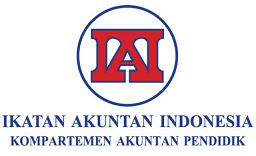ANALISIS PENERAPAN EXPECTED CREDIT LOSS (ECL) TERHADAP PEMBENTUKAN CADANGAN KERUGIAN PENURUNAN NILAI MENURUT PSAK NO. 71 PADA LEMBAGA PEMBIAYAAN DI INDONESIA
Abstract
This study aims to measure impairment losses (CKPN) before and adfter the application Expected Credit Loss (ECL method of PSAK 71, as well as the difference in net income before and after the application of the Expected Credit Loss (ECL) method according to PSAK 71 at financial institutions in Indonesia. The object of this research is sixteen financial institutions which are included in the sample criteria. This study uses a quantitative method by conducting a different type of Wilcoxon Signed t-test. Based on the different test results in the first and second hypotheses, the significance value is <0.05, which means that there is a significant difference in the amount of Impairment Loss (CKPN) between before and after the application of the Expected Credit Loss (ECL) method according to PSAK 71 and there is a significant difference in net income between before and after the application of the Expected Credit Loss (ECL) method according to PSAK 71. The ECL method makes the CKPN value large because it considers the possibility of credit risk, so that CKPN recorded as an expense will reduce the net profit generated by the company.
Downloads
References
Exposure Draft. 2013. Pernyataan Standar Akuntansi Keuangan Instrumen Keuangan: Pengakuan dan Pengukuran PSAK No. 55. Ikatan Akuntan Indonesia.
Fitriana, E.M., dan Arfianto, D.E. 2015. Analisis Pengaruh NPL, CAR, ROA, LDR dan SIZE Terhadap CKPN (Studi Kasus pada Bank Konvensional yang Tercatat di Bursa Efek Indonesia 2010-2014). Diponegoro Journal Of Management. 4(4): 1-8.
Hery. 2015. Pengantar Akuntansi Comprehensive Edition. Jakarta: PT. Grasindo.
Kieso, D. E., J. J. Weygandt, dan T. D. Warfield. 2011. Intermediate Accounting. Twelfth Edition. USA: John Wiley & Sons, Inc. Terjemahan E. Salim. 2008. Akuntansi Intermediate. Edisi Tahun 2011. Jilid 1. Jakarta: Erlangga.
Kustina, K.T., dan Putra, I.G.P.N.A. 2021. Implementasi Psak 71 Januari 2020 Dan Profitabilitas Perbankan Di Indonesia. Jurnal Ilmiah Akuntansi dan Bisnis. 6(1): 44-52.
Margono. 2010. Metodologi Penelitian Pendidikan. Jakarta: Rineka Cipta.
Martani, Dwi. 2012. Akuntansi Keuangan Menengah Berbasis PSAK. Jakarta: Salemba Empat
Muhammad, A. dan Muniarti, R. 2000. Segi Hukum Lembaga Keuangan dan Pembiayaan. Bandung: Citra Aditya Bakti.
Otoritas Jasa Keuangan. 2014. Salinan Peraturan Otoritas Jasa Keuangan Nomor 29/Pojk.05/2014 Tentang Penyelenggaraan Usaha Perusahaan Pembiayaan. Jakarta: Otoritas Jasa Keuangan.
Rahayu, Duwi. 2021. Analisis Implementasi PSAK 71 Terhadap Cadangan Kerugian Penurunan Nilai (Studi Kasus pada Pt Bank XYZ Tbk). Jurnal Akuntansi Integratif. Vol 7(1): 13-25.
Soemarsono. 2009. Akuntansi Suatu Pengantar. Jakarta: Salemba Empat.
Sugiarto. 2002. Pengantar Akuntansi. Jakarta: Pusat Penerbitan Universitas Terbuka.
Sugiyono. 2015. Metode Penelitian Pendidikan. Bandung: Alfabeta.
Suroso. 2017. Penerapan PSAK 71 dan Dampaknya Terhadap Kewajiban Penyediaan Modal Minimum Bank. Jurnal Bina Akuntansi. 4(2): 157-165.
Sutriasih, Emi., I.G.C. Putra. dan I.G.A. Suryawathy. 2013. Pengaruh Informasi Laba Bersih, Arus Kas, Dan Publikasi Deviden Pada Volume Perdagangan
Perusahaan Manufaktur Di Bursa Efek Indonesia. Jurnal Ilmiah Akuntansi dan HUMANIKA. Vol 3(1): 1055-1070.
Syaiful, Bahri. 2016. Pengantar Akuntansi Berdasarkan SAK ETAP dan IFRS. Yogyakarta: CV. Andi Offset.
Tim Penyusun Pedoman Akuntansi Perbankan Indonesia. 2008. Pedoman Akuntansi Perbankan Indonesia Buku 2. Jakarta: Bank Indonesia.
Witjaksono, Armanto. 2018. Perbandingan Perlakuan Akuntansi Kredit Menurut PSAK 55, PSAK 71, dan Basel pada Bank Umum. Jurnal Online Insan Akuntan. 3(2): 111 – 120.

This work is licensed under a Creative Commons Attribution-NonCommercial-ShareAlike 4.0 International License.
Jurnal Akutansi dan Keuangan allows readers to read, download, copy, distribute, print, search, or link to the full texts of its articles and allow readers to use them for any other lawful purpose. The journal allows the author(s) to hold the copyright without restrictions. Finally, the journal allows the author(s) to retain publishing rights without restrictions
Authors are allowed to archive their submitted article in an open access repository
Authors are allowed to archive the final published article in an open access repository with an acknowledgment of its initial publication in this journal







